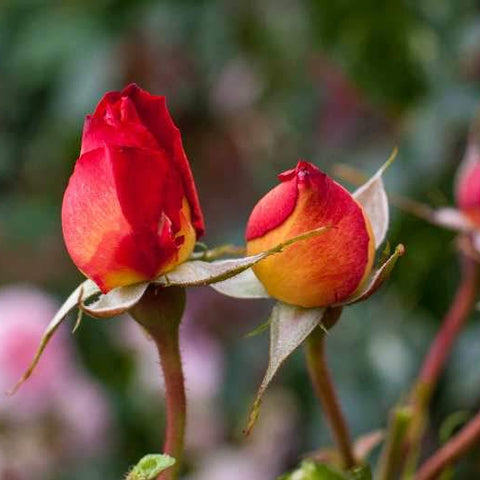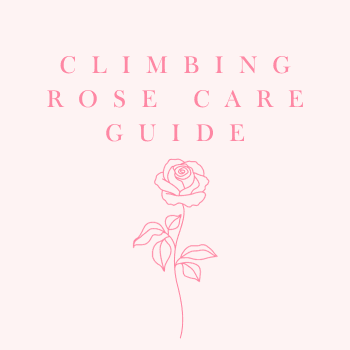Climbing Roses Care Guide
Quick Facts
- Hardiness: Fully hardy. Suitable for growing across the UK and Ireland.
- Height: Up to 4m in summer
- Flowering: Summer until late Autumn
- Planting: Throughout Autumn, and late Winter to early spring
- Ideal for: Trellis training
- Also suitable for: Training against any other upright surface
- Difficulty: Medium
Climbing roses have been a popular choice for centuries, and are indispensable for adding lasting romance and fragrant beauty to the garden, not to mention concealing ugly garden structures. They are a particularly popular choice for occasions that celebrate love due to their romantic symbolism, our most popular example is the White Wedding Climbing rose for weddings. Although they are not self-supporting, climbing roses can be trained to grow over almost anything that has horizontal supports to tie them to making them low-maintenance and high-reward roses

Due to their popularity, climbing roses have been developed from every single modern category of roses, and most traditional ones, which is why they have no formal classification as such.
Autumn (October - November) and early spring are the ideal times to plant your roses. If you receive your rose in summer, remove all packaging immediately and place it outside. Keep well watered and plant as soon as you can into the ground. If you receive your rose in winter, remove all packaging and make sure the soil is damp. Store your rose in an unheated shed/greenhouse to protect the plant from frosts until early spring, the perfect time for planting.
Where to Plant your Climbing Roses
Before planting your climbing rose, make sure whatever supporting structure you will be growing it against is in good condition, and secure enough to support the full weight of the rose when it matures. As previously mentioned, you will need to ensure there are horizontal supports to tie the rose bush too, so if you are planting the rose against a shed or brick wall, you may need to install a trellis first.
How to Grow Climbing Roses in Pots
Rose bushes are known to have deep, fibrous root systems so large pots are needed so that you are able to grow a healthy plant.
The large root systems can present a problem when trying to grow climbing roses in pots as some can grow to large heights of up to 12ft meaning they have big root systems to match.
Choose a smaller variety that will be adapted to living in a container, miniature roses tend to be the best option.
Start by repotting the plant from the current pot into an 8 - 20L pot. The pot should be able to accommodate the vigorous growth of the rose.
Add a trellis to the back of the pot for the rose to climb on and you're good to go.
Prune the rose as you would prune normally to keep a nice form and a healthy plant.
Planting your Climbing Rose Bush
An hour before planting your rose, water it thoroughly. Create a mix of soil, compost and organic rose food in a separate container. Dig a hole roughly twice the width of the plant's container around 40cm from the supporting structure. Choose a nice sunny spot in the garden, as roses need at least 6 hours of sunlight a day, somewhere with well-draining soil that will not become waterlogged. If the soil is poor quality or clay-like, it is advisable to add a layer of compost to the subsoil. Also, if you tend to get a lot of wind, please pick somewhere which will provide your rose with some shelter.
Remove the entire rose plant from its container and gently tease out the roots. Prune any that are damaged or broken, then plant the rose with the bud union at ground level. Backfill any gaps with the soil mix you made earlier but do not pack the soil too tightly around the new rose.

Training Climbing Roses
Climbing roses have two types of growth: structural canes, and flowering shoots which grow from them. Structural canes do not produce flowers, so it is important to train the structural canes to grow at an angle, as this will encourage them to grow flowering shoots low down, instead of just at the very top of each cane.
To begin training them, choose the sturdiest structural canes, and tie them loosely to the supporting trellis, as close to horizontal as possible. As the structural canes grow, ensure it has as many flowers as possible by winding it from side to side of the trellis structure, tying it off at regular intervals.
Feeding Climbing Roses
Most rose varieties have healthy appetites, so feed them every spring with a powder or granular rose fertiliser, and again in June or July. You can do this with any good quality fertiliser from your local garden centre, or you can order rootgrow fertiliser online from most green retailers.
Mulching around Climbing Roses
Mulching is the term used for the layer of organic material that is placed on top of the soil around your plants every year. It has a whole host of benefits, including keeping the soil moist throughout summer and discouraging blackspots and weeds. The best time to do this is in late Spring (April-May) or Autumn (October)
First, prepare the ground by removing debris and weeds and water the surface of the soil if it is dry. If mulching in spring, apply the spring feed if this has not been done, then hoe the ground lightly to mix in.
Apply a thin layer of well-rotted manure or good garden compost all around the roses - we suggest using John Innes No. 3.
Watering Climbing Roses
Roses are deep-rooted plants, which means that in some seasons they may not require watering at all. However, the fact they are deep-rooted means the plants won’t show signs of drought as quickly as other plants in your garden, and under-watering can lead to impaired growth, so approach with caution! We recommend that you water the base of the plant only, and try to avoid getting water on the leaves, as this will encourage leaf scorch and disease.
We advise you to water your rose regularly watering until the plant is established. Once this point is passed, the plant will only require watering through spring and summer. When the weather is temperate, water deeply once a week, but in the height of summer, your rose may require water every day.
How to Prune Climbing Roses
Climbing roses will not require pruning in the first year or so (apart from removing broken or dead branches), while they establish themselves. After this, your rose will require pruning in early spring each year. Climbing roses flower on the year's new growth, so this will encourage better blooming.
Begin by cutting out any dead, overcrowded or exhausted wood. Then shorten any flowering shoots by around two-thirds.
Deadheading Climbing Roses
Deadheading is the process of removing flowers from your plant once they are dying or dead. This will help your rose to redirect its energy into making new flowers. Cut the dead rose away, cutting just before the first leaf down.
Climbing Roses in Winter
If weather conditions are expected to be extreme, you should provide your climbing rose bushes with some protection. You can use sacking, horticultural fleece or even some bin liners to make sure your bushes don’t get frost damaged, Protect the base of the plant and the bud union by piling extra compost around the stems at the base of the plant. Remove this protection when the worst of the winter frosts have passed.
See our care guides for hybrid tea roses, patio roses and floribunda roses.
